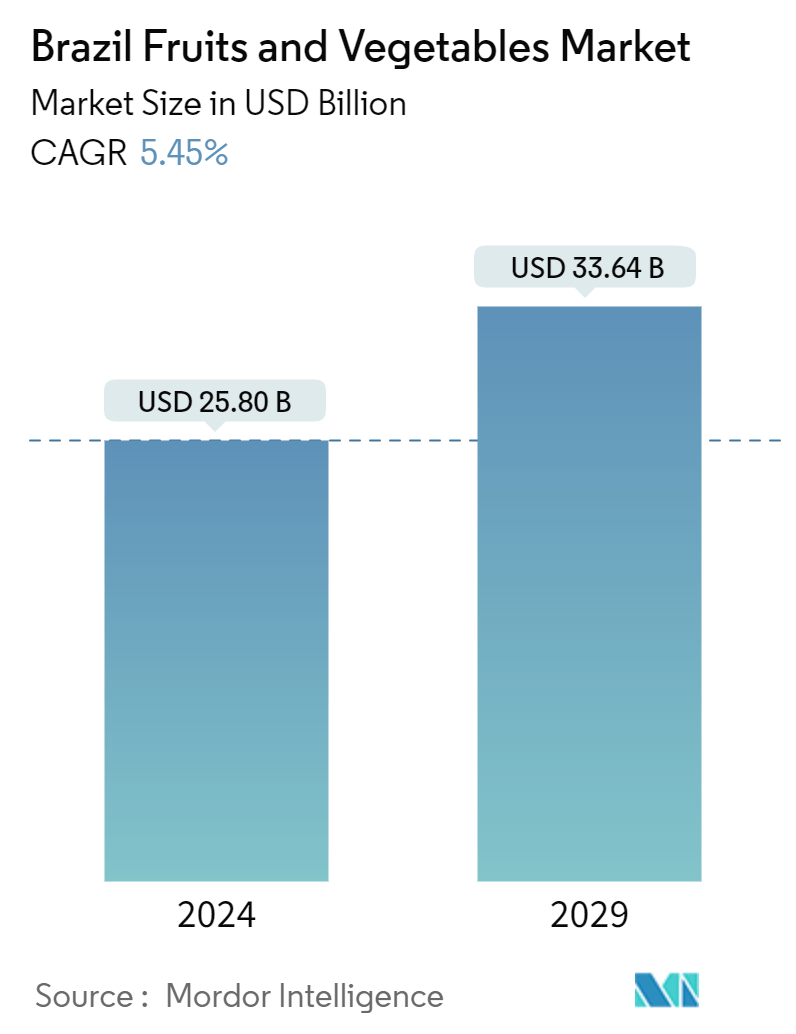Market Size of Brazil Fruits And Vegetables Industry

| Study Period | 2019 - 2029 |
| Base Year For Estimation | 2023 |
| Market Size (2024) | USD 25.80 Billion |
| Market Size (2029) | USD 33.64 Billion |
| CAGR (2024 - 2029) | 5.45 % |
| Market Concentration | Medium |
Brazil Fruits And Vegetables Market Analysis
The Brazil Fruits And Vegetables Market size is estimated at USD 25.80 billion in 2024, and is expected to reach USD 33.64 billion by 2029, at a CAGR of 5.45% during the forecast period (2024-2029).
Brazil's fruits and vegetables market is a dynamic sector in the country's agribusiness, leveraging its vast geographical area, favorable climate, and rich biodiversity. This sector significantly contributes to both domestic consumption and international trade, with a wide range of tropical and temperate produce grown across various regions.
Brazil ranks among the world's top producers of fruits, including oranges, bananas, pineapples, and papayas. According to the Food and Agriculture Organization, in 2022, Brazil produced 16.9 million metric tons of oranges, 6.9 million metric tons of bananas, 2.3 million metric tons of pineapples, and 1.1 million metric tons of papayas. As the world's largest orange producer, Brazil dedicates a significant portion of its output to juice production. The United States Department of Agriculture reports that as of 2023, Brazil accounts for 72% of global orange juice production. While banana and pineapple production is substantial, it primarily serves domestic consumption. The vegetable sector in Brazil is diverse, with key crops including tomatoes, potatoes, onions, and carrots. Unlike the fruit sector, which often involves larger commercial farms, vegetable production is more fragmented and characterized by a higher proportion of smallholder farmers.
Brazil's domestic fruits and vegetables market is experiencing growth, driven by the expanding middle class and increasing urbanization. Health-conscious Brazilian consumers are fueling demand for fresh produce, including exotic and minimally processed options. Supermarkets and urban food retailers are becoming key distribution channels for fresh produce, while traditional street markets remain important in smaller towns and rural areas. Fruit exports are a vital component of Brazil's agricultural economy, with the European Union serving as a primary destination, particularly for mangoes, melons, and table grapes. The country is also exploring new markets in Asia and the Middle East to diversify its export base to China, South Korea, Japan and Taiwan. The Brazilian fruits and vegetables market is anticipated to grow due to its diverse production, rising domestic demand, and strong export potential.
Brazil Fruits And Vegetables Industry Segmentation
The Brazilian fruits and vegetables market is segmented by type (fruits and vegetables). The report includes production (volume), consumption (volume and value), import (volume and value), export (volume and value), and price trend analysis. Price analysis covering the top 10 fruits and vegetables across Brazil has also been included. The report offers market size and forecast in terms of value in USD million and volume in metric tons for the above-mentioned segments.
Brazil Fruits And Vegetables Market Size Summary
The Brazil Fruits and Vegetables Market is poised for significant growth, driven by factors such as technological advancements, a growing population, and robust economic development. The market is characterized by a diverse range of produce, with bananas and oranges dominating the fruit sector, while tomatoes are a key vegetable crop. The Brazilian government is actively investing in the agricultural sector to enhance production capabilities and meet both domestic and export demands. This includes the adoption of smart-farming technologies like IoT, farm-management software, and drones, which are increasingly being utilized to optimize agricultural practices. Precision agriculture, in particular, has seen a notable uptake, especially in horticultural crops, contributing to improved farm management and productivity.
Brazil's agricultural landscape is further bolstered by its status as a leading producer of oranges and a significant player in the global fruit and vegetable market. The country is a major exporter, with key markets including the United Kingdom, the United States, and several European countries. The state's S√£o Paulo is a central hub for production, reflecting the country's strategic focus on enhancing its agricultural output. The growing interest in greenhouse vegetable production is also noteworthy, driven by urbanization, increased consumer income, and concerns over food safety and sustainability. These trends underscore Brazil's commitment to maintaining its leadership position in the global fruits and vegetables market.
Brazil Fruits And Vegetables Market Size - Table of Contents
-
1. MARKET DYNAMICS
-
1.1 Market Overview
-
1.2 Market Drivers
-
1.2.1 High Export Growth Potential for Oranges
-
1.2.2 Domestic Demand for Vegetables in Brazil
-
1.2.3 Diverse Climate Zones Supports Production of Fruits and Vegetables
-
-
1.3 Market Restraints
-
1.3.1 Competition from Traditional Field Crops
-
1.3.2 Poor Infrastructure Facilities for Timely Distribution
-
-
-
2. MARKET SEGMENTATION
-
2.1 Vegetables
-
2.2 Fruits
-
Brazil Fruits And Vegetables Market Size FAQs
How big is the Brazil Fruits And Vegetables Market?
The Brazil Fruits And Vegetables Market size is expected to reach USD 25.80 billion in 2024 and grow at a CAGR of 5.45% to reach USD 33.64 billion by 2029.
What is the current Brazil Fruits And Vegetables Market size?
In 2024, the Brazil Fruits And Vegetables Market size is expected to reach USD 25.80 billion.

